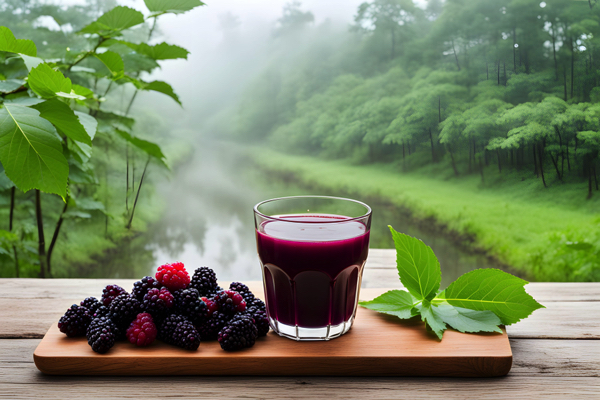
Its reputation extends far beyond being a simple source of fruit – it has been praised as the "tree of life" and the "herb of immortality."
Mulberries offer a unique blend of nutrients, making them a valuable addition to any diet. Fresh mulberries are composed of about 88 percent water and contain only 60 calories per cup (140 grams). In terms of nutritional content, they provide approximately 9.8 percent carbohydrates, 1.7 percent fiber, 1.4 percent protein, and just 0.4 percent fat. When dried, mulberries – much like raisins – become even more concentrated, with around 70 percent carbohydrates, 14 percent fiber, 12 percent protein and 3 percent fat. This makes dried mulberries notably high in protein compared to other berries.
In addition to their balanced macronutrients, mulberries are also rich in essential vitamins. They contain notable amounts of vitamins A, C, B1, B2, B3, B6, B9, E and K1.
The mineral content of mulberries is equally impressive, with significant levels of calcium, copper, iron, magnesium, manganese, potassium, sodium and zinc. These minerals play a crucial role in maintaining overall health – from supporting bone health to boosting the immune system.
Mulberry leaves also pack a nutritional punch. They are a source of powerful antioxidants like flavonoids, flavonols and terpenoid phenols. Additionally, the leaves contain essential polyunsaturated fatty acids linoleic acid and linolenic acid, which are vital for maintaining heart health. They also provide essential amino acids, such as cysteine, histidine, isoleucine, leucine, lysine, methionine, phenylalanine, threonine tryptophan, tyrosine and valine. New amino acids like morusimic acids A to F have also been discovered in mulberry leaves using advanced spectroscopic methods.
The phytonutrient composition of mulberries can vary depending on factors, such as species, climate, growing conditions and soil composition. Despite these variables, mulberries consistently offer a robust array of nutrients that support overall health and aid in disease prevention.
Nutraceutical abilities and therapeutic potential of mulberries
Mulberries are more than just a nutritious fruit. They are also a powerhouse of health-promoting and therapeutic properties that contribute to human health and well-being. Here are some of the ways mulberries can support overall wellness:
Anti-aging
Mulberry extracts have demonstrated anti-aging effects by reducing oxidative stress, which is a major cause of visible aging. A 2024 study published in the Journal of Functional Foods, showed that dried mulberry fruit extracts improved skin appearance and protected against oxidative stress in both lab and animal studies.
Anticancer
Mulberry’s potential in cancer prevention and treatment is an area of growing interest. Its fruit, leaves and bark contain bioactive compounds that have been shown to inhibit the growth of cancer cells and reduce the risk of cancer development. Key compounds, like alkaloids, flavonoids and phenolics found in mulberries contribute to these effects by targeting the mechanisms that allow cancer cells to grow, spread and survive.
Studies have shown that mulberry extracts can suppress the proliferation of various types of cancer cells, including breast, colon, liver and lung cancers. The high antioxidant content in mulberries also plays a role in preventing oxidative damage to cells, which is a major contributor to cancer formation. Mulberries help protect DNA from oxidative stress – reducing mutations that could potentially lead to cancerous growths.
Another promising component is resveratrol – a potent antioxidant present in mulberries that has demonstrated anti-cancer activity in both lab and animal studies. Resveratrol is known for its ability to interact with cancer signaling pathways, induce apoptosis (programmed cell death in cancer cells) and inhibit angiogenesis – the process by which tumors develop new blood vessels to sustain their growth. This makes mulberry an exciting natural option for both cancer prevention and complementary cancer treatment.
Anti-hyperglycemic (blood sugar control)
Mulberry’s ability to regulate blood sugar levels makes it valuable for individuals with diabetes or those at risk of developing the condition. The leaves of the white mulberry have been used in traditional Chinese medicine for centuries to manage diabetes and modern research confirms their effectiveness.
The key lies in the functional chemical compounds within the leaves, such as DNJ (1-deoxynojirimycin) and polysaccharides, which have been found to inhibit enzymes that break down carbohydrates into glucose. This slows the absorption of sugar into the bloodstream – preventing spikes in blood sugar after meals. For individuals managing diabetes, mulberry can help maintain more stable blood sugar levels throughout the day.
Anti-hyperlipidemic (cholesterol and weight management)
Mulberries may help lower cholesterol and support reasonable weight management goals. One study found that consuming 45 grams of mulberries daily for six weeks significantly reduced total cholesterol and LDL (bad) cholesterol in humans aged 30 to 60. Additionally, mulberry leaf extracts rich in DNJ (1-deoxynojirimycin) were found to lower triglyceride levels and activate fat-burning processes in obese mice – suggesting its strength in combating obesity and preventing liver fat accumulation.
Mulberry extracts have shown the ability to reduce obesity by promoting fat breakdown and preventing the accumulation of fat in the liver. Additionally, mulberry leaf extract fermented with Cordyceps militaris has been shown to stimulate fat breakdown in fat cells – offering a potential for managing obesity.
Anti-inflammatory
Mulberries, especially their fruits and leaves, are packed with anti-inflammatory compounds, like anthocyanins, flavonoids and phenolic acids, which work by inhibiting the production of pro-inflammatory substances in the body. In particular, mulberry leaf extract has been shown to reduce the activity of nuclear factor-kappa B – a protein complex that plays a central role in controlling inflammation and preventing the development of chronic inflammatory diseases.
In experiments on mice, mulberry extracts reduced inflammation in conditions, like xylene-induced ear edema and carrageenan-induced paw edema.
Mulberries are rich in antioxidants that fight free radicals, which are harmful molecules that can damage cells and contribute to diseases like cancer and heart disease. The high antioxidant content helps protect the body from oxidative stress – promoting health and longevity.
Antimicrobial
Various parts of the mulberry plant, particularly the leaves and bark, contain compounds that can fight a wide range of harmful microorganisms. These natural defenses make mulberry a candidate for combating infections caused by bacteria, fungi and viruses.
Mulberry leaves have been shown to possess anti-bacterial properties. Studies have demonstrated that ethanol extracts from the leaves can effectively inhibit the growth of methicillin-resistant Staphylococcus aureus – a bacteria commonly responsible for skin infections, such as abscesses, boils and cellulitis. In severe cases, S. aureus can cause dangerous bloodstream infections, bone infections or pneumonia. (Related: The leaves of dyer’s mulberry can protect against staph infections.)
Mulberry bark also exhibits activity against other bacteria like Escherichia coli (that can produce toxins harmful to the intestines) and Salmonella typhimurium (a leading cause of Salmonella infections). The anti-bacterial compounds in mulberry, particularly phenolic compounds, like quercetin contribute to these effects.
The anti-microbial properties of mulberry extracts are concentration-dependent – meaning their effectiveness increases with higher doses. This flexibility allows mulberry-derived products to be adjusted for different types of infections and varying severity.
Anti-schistosomal (fighting parasitic infections)
Mulberry extracts have demonstrated promising results in combating parasitic infections, particularly schistosomiasis – a disease caused by the Schistosoma parasite. Schistosomiasis affects millions of people worldwide, especially in developing regions – leading to long-term health complications, such as liver damage, kidney failure and bladder cancer.
Anxiolytic (stress relief)
Studies have found that mulberries have anxiolytic properties. This means they can help reduce anxiety and promote a sense of calm – naturally uplifting mood.
Cardioprotective
Mulberries may also benefit those suffering from high blood pressure (hypertension) – a major risk factor for heart disease and stroke. The anti-hypertensive properties are largely due to its ability to improve the function of blood vessels and reduce inflammation – both of which are key factors in maintaining healthy blood pressure levels.
Mulberries may help reduce the buildup of plaque in the arteries – a process known as atherogenesis. This makes mulberries beneficial for heart health by lowering the risk of heart disease.
Mulberry extracts contain flavonoids and potassium, which help relax blood vessels and promote better circulation. These compounds also act as natural diuretics – encouraging the body to excrete excess sodium, which helps lower blood pressure.
Hormonal support
Mulberries can help promote the synthesis of estrogen and progesterone – hormones that play a vital role in reproductive health.
Neuroprotective
Mulberry extracts have neuroprotective effects – meaning they help protect the brain and nervous system from damage, which could be beneficial in preventing or managing neurodegenerative diseases, like Alzheimer’s and Parkinson’s diseases.
With such a broad spectrum of health-enhancing properties, mulberry truly stands out as a superfood with nutraceutical potential – offering therapeutic solutions for many modern health challenges – from diabetes and heart disease to inflammation and infections. Whether consumed as fresh fruit, dried or in extract form, mulberries play a vital role in promoting overall health and well-being.
Watch this video about the 10 amazing health benefits of mulberry tea.
This video is from the Daily Videos channel on Brighteon.com.
More related stories:
Compounds in white mulberry can help treat metabolic syndrome, says research.
Morus alba (white mulberry) extracts can be used to suppress appetite and manage body weight.
Mulberry compound found to fight obesity, high cholesterol, high blood sugar and even cancer.
Sources include:
Please contact us for more information.






















